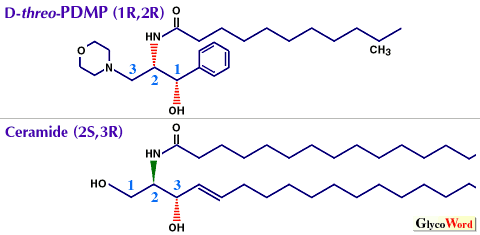| Inhibitors of Glycosphingolipid Biosynthesis | |
|
 |
The experimental approach to deplete cellular glycosphingolipids (GSLs) with the specific inhibitors of glycosphingolipid biosynthesis has the potential to identify functions of endogenous GSLs. Most GSLs are derived from glucosylceramide (GlcCer), which is synthesized from ceramide and UDP-glucose. The sequential addition of further monosaccharide and sialic acid to GlcCer results in a complex family of structures, such as the ganglio, globo, isoglobo, neolacto and lacto series.
It has been demonstrated by Inokuchi and Radin (1) that an analog of ceramide, D-threo-1-phenyl-2-decanoylamino-3-morpholino-1-propanol (D-PDMP, Fig. 1) inhibits UDP-glucose:N-acylsphingosine glucosyltransferase (EC. 2.4.1.80), which produces GlcCer. Kinetic analysis showed that D-PDMP acted by mixed competition against ceramide with IC50 and Ki values of 5 microM and 0.7 microM, respectively. It should be noted that PDMP does not inhibit UDP-galactose:N-acylsphingosine galactosyltransferase and beta-glucocerebrosidase. As shown in Fig. 1, the stereospecific action of PDMP was demonstrated very clearly, since only one of the four PDMP isomers, D-threo isomer (1R, 2R), was able to inhibit GlcCer synthesis.
| |
|

Structures of PDMP and Ceramide |
|
|
Many recent studies have demonstrated that D-PDMP affects various biological events, such as inhibition of cell attachment migration to laminin, experimental metastasis, IL2-stimulated lymphocyte proliferative responses; decarcinogenic activity against Shope carcinoma, enhancement of bradykinin-stimulated formation of myoinositol-1-4-5-triphosphate; identification of GQ1b as an essential molecule for synaptic function. D-PDMP not only suppresses GSL biosynthesis, but also accumulates ceramide and sphingoid bases. Therefore, one should consider carefully both effects of D-PDMP for interpretation of the effects.
When cells were treated with the series of PDMP analogs having different lengths of acyl chains, the longer acyl chain analogs, C14 (PMMP) and C16 (PPMP), were taken up much more effectively by cells and this difference explains the much greater effectiveness of PMMP and PPMP in intact cells. Moreover, a morpholinoceramide having unnatural ceramide configuration (2R, 3R) like D-PDMP was a much stronger inhibitor of GlcCer synthase than its natural one (2S, 3R) and the other isomers. Because it is clear from these observations that the inhibitory activity of PDMP on GlcCer synthase was found only in the D-threo (1R, 2R) isomer, which has a different configuration of the N-acyl group compared with natural ceramide, further study to elucidate this stereospecific action is underway (2).
Recently, it was found that N-butyldeoxynojirimycin, known as an inhibitor against alpha-glucosidase I, also inhibits GlcCer synthase. Among various N-alkylimino sugars tested, N-butyldeoxygalactonojirimycin possesses no visible cytotoxicity and higher specificity for the inhibition of GlcCer synthesis. Much progress will be expected on the mechanism of GlcCer synthesis inhibition by these N-alkylimino sugars and on its medical application for treatment of Gaucher's disease.
| |
|
| Jin-ichi Inokuchi (Graduate School of Pharmaceutical Sciences, Hokkaido University) | |
| | |
|
| References | (1) | Inokuchi J, Radin NS J. Lipid Res. 38, 565-571, 1987. |
| (2) | Inokuchi J TIGG 9, S37-S45, 1997. |
| | |
| |
| Mar.15, 1999 |
|
| |
|
|
|
|



